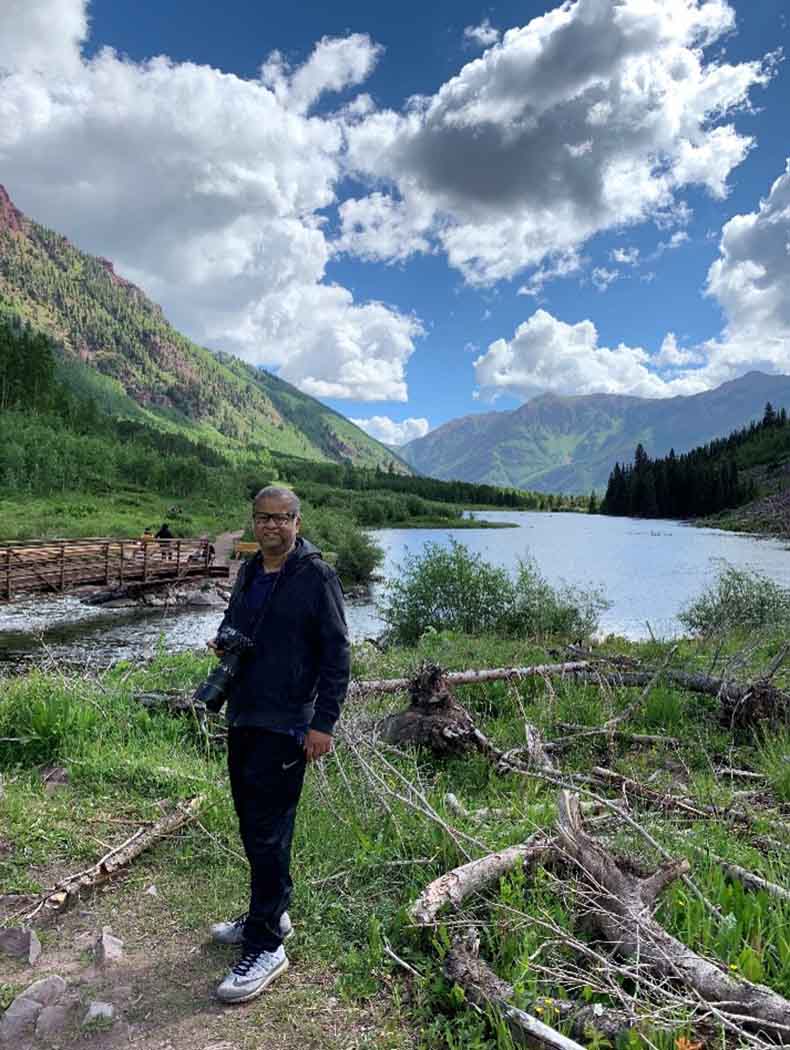Abhishek Roy's Research Is Insane in the Membrane
How One Researcher Is Helping Reduce Global Energy Use, Generate Clean Drinking Water, Capture Carbon, and Generally Save the Planet
If you drink tap water, you can probably thank Abhishek Roy.
A good amount of the world’s drinking water gets purified through something called a reverse osmosis membrane, which filters out salt and other contaminants. And if your water squeezes through this kind of filter, it is likely that Roy helped build it. But even if you cannot thank Roy for that particular membrane, there is a good chance you will benefit from at least one of his many others. He currently holds 75 patents worldwide.
“Membranes are an enabling technology,” said Roy, a senior staff scientist at the National Renewable Energy Laboratory (NREL). “Membranes play a very, I would say, behind the screens—or scenes—role to provide one of the most crucial parts of today’s life: clean water.” (“Screens” was not a slip of Roy’s tongue; it’s a membrane pun!)

As greenhouse gases like carbon dioxide trap heat in our atmosphere and a warming climate strains our water supplies, these little enablers are becoming even more valuable. Roy’s most prolific membrane not only improves water quality by 40%, but it also uses 30% less energy than its predecessors. Those energy cuts could help reduce global carbon emissions and slow climate change—and so could Roy’s hydrogen-powered fuel cells, which need membranes to generate clean energy for things like power plants, cars, or even laptops.
But Roy is not only preventing new emissions; his inventions could also help remove carbon that has already escaped into our atmosphere or our oceans.
“There is now a global need for decarbonization, right?” Roy said. “And we are trying to help in every possible way.”
In short, Roy is an enabler for the enablers.
Roy first encountered membranes during his doctoral studies at Virginia Tech. His background was in polymers—the molecular chains behind synthetic materials, like plastics, but also natural structures, like DNA. But his advisor, James McGrath, was “a very forward-looking person,” Roy said. And McGrath wanted to find a way for polymers to boost the green technology movement.
“I got my Ph.D.,” Roy said, “but also a doctorate in understanding membranes and how they can solve world problems.” (He got something else, too: a prestigious R. A. Glenn Award from the fuel division of the American Chemical Society for his doctoral thesis, which led to a breakthrough in fuel cell research).
Membranes require energy—sometimes a whole lot of energy—to push substances through their selective layers. So, if researchers could build more energy-efficient membranes, those energy savings could significantly reduce global carbon emissions (and costs), too.

Roy’s inventions do exactly that. His favorite invention, the water purification membrane that cut energy use by 30%, earned him the Gordon E. Moore Medal, one of the most highly esteemed awards available for members of the chemical industry. Now, he is working to realize yet another of McGrath’s antipollution plans.
“Thirty years back, fuel cells were a dream,” Roy said. “Now, they’re no longer a dream; they’re a reality.”
That reality runs on membranes. In fuel cells, membranes separate hydrogen to generate energy while emitting nothing but water. Roy also helped invent more energy-efficient membranes for petrochemical industries, which produce products like plastics, medical equipment, fertilizers, and even clothing. With Roy’s membranes, those industries could both reduce their overall energy consumption (and therefore their carbon emissions) and capture carbon, too.
Now, at NREL, Roy is working to make fuel cells, water-purification devices, and carbon-capture technologies more efficient and cost effective. “That’s my goal—to establish the lab as a national hub and help to address those challenges,” Roy said.
Before Roy joined NREL in 2021, he spent about 15 years at Dow Chemical. Throughout that time (and even in the two years since he joined the laboratory), Roy has earned many high-profile awards, especially for his water purification technologies. Most recently, he and Mou Paul, a materials scientist at NREL, won the 2023 Polymer Science and Engineering Cooperative Research Award for their work in global water sustainability. Roy also earned the 2014 Virginia Tech Outstanding Recent Alumni Award and Dow Chemical’s coveted Sustainability Innovator Award (as of 2014, Roy was one of just five recipients). And he was recently elected to the board of directors for the North American Membrane Society.
In May 2023, the membrane magician was awarded funding from the National Alliance for Water Innovation (NAWI), whose mission is to make water more affordable, energy efficient, and accessible. With his award, Roy, a member of the NAWI Alliance and research consortium, is crafting yet another multipurpose membrane.
“As you purify water, you leave behind salt. What happens to this salt? That’s a big question,” Roy said. “And salt water will also contain water, right? Every drop of water counts.”

Typically, that salty byproduct is tossed away or left to evaporate. But Roy’s latest membrane can extract those precious drops of pure water, as well as salts needed for chemical processes. This kind of purification often demands huge amounts of energy (the more stuff that is in the water, the harder it is to push it through a membrane). But Roy’s solution, which he is working on with collaborators at the University of Texas and Lawrence Berkeley National Laboratory, will reduce both energy use and costs.
“That’s the major goal—reducing the overall cost of water,” Roy said. (He is also adapting that membrane to remove carbon from seawater thanks to a grant from the Office of Naval Research). “But if you want to develop this decarbonization technology,” Roy continued, “it’s very important that you engage not only the top leaders but also people who are emerging.”
About five years ago, Roy was chosen to join the National Academies of Sciences, Engineering and Medicine’s New Voices project, which aims to encourage early-career scientists to tackle national and global challenges.
“Of course, technology is the key, right?” Roy said. “But engaging the young scientific community into the whole process—that’s so critical.”
Now, Roy is not only an enabler for his mini membrane enablers but also for the next generation of scientists who will take up the fight against climate change, one polymer, fuel cell, water droplet, or carbon molecule at a time.
The National Alliance for Water Innovation is a public–private partnership that brings together a world-class team of industry and academic partners to examine the critical technical barriers and research needed to radically lower the cost and energy of desalination. The alliance is led by the U.S. Department of Energy’s Lawrence Berkeley National Laboratory in collaboration with DOE's National Energy Technology Laboratory, National Renewable Energy Laboratory, and Oak Ridge National Laboratory and is funded by DOE's Industrial Efficiency and Decarbonization Office.
Last Updated May 28, 2025
